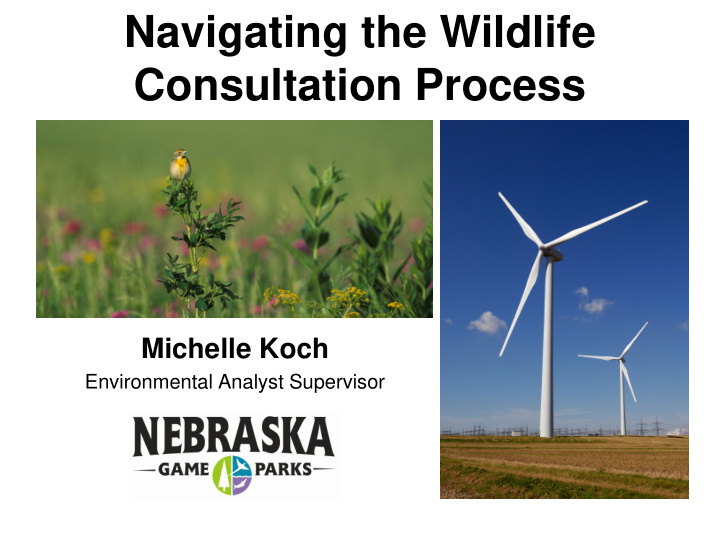



Navigating the Wildlife Consultation Process Michelle Koch Environmental Analyst Supervisor
Introduction • Nebraska Game and Parks Commission (NGPC) is responsible for protecting and managing wildlife and natural habitats • Work proactively with developers • Address wildlife concerns during the site selection and planning phase
Overview of Consultation Process 1. Encourage pre-siting review 2. Review guidance documents 3. Contact agency personnel & submit project information for review 4. Meetings and/or site visits 5. Develop survey methods 6. Conduct 2 years of pre- and post- construction surveys & submit reports – in some cases more than 2 years may be needed
1. Pre-siting Review
2. Review Guidance Documents • Guidelines for Wind Energy and Wildlife Resource Management* • USFWS Land-Based Wind Energy Guidelines • Wind and Wildlife Map* • Avian Assessment Guidance * • Bat Assessment Guidelines (in draft) * http://outdoornebraska.ne.gov/wildlife/windwildlife.asp
2. Review Guidance Documents • Guidelines for Wind Energy and Wildlife Resource Management in Nebraska – The Nebraska Wind and Wildlife Working Group – Purpose: provide consistent statewide guidance for the development of wind energy projects that avoid, minimize, and mitigate impacts to wildlife and their habitats in Nebraska – Does not substitute for a site specific review http://outdoornebraska.ne.gov/wildlife/windwildlife.asp
2. Review Guidance Documents • Guidelines for Wind Energy and Wildlife Resource Management in Nebraska – Pre-construction site assessment – Practices to avoid and minimize impacts to wildlife – Post-construction operational monitoring – Mitigation for long-term habitat impacts – Research http://outdoornebraska.ne.gov/wildlife/windwildlife.asp
2. Review Guidance Documents http://outdoornebraska.ne.gov/wildlife/windwildlife.asp
2. Review Guidance Documents • Assist with designing surveys & reporting – Whooping Crane – Mountain Plover – Breeding Bird – Nesting Raptor – Prairie Grouse • Produce defensible results • Make sound decisions – Location & Mitigation http://outdoornebraska.ne.gov/wildlife/windwildlife.asp
2. Review Guidance Documents Avian Assessment Guidance • Two years pre- and post- construction surveys • Allow flexibility with methods – Still want to estimate detection probabilities and corrected densities • Species specific surveys • Specific surveys in migratory corridors or stop-over locations http://outdoornebraska.ne.gov/wildlife/windwildlife.asp
3. Contact Agency Personnel and Submit Project Information Michelle Koch Martha Tacha • Location, timeframe, size, number & type of turbines, substations, transmission lines, access roads, temporary concrete plants, etc.
3. Contact Agency Personnel and Submit Project Information • Environmental Review – Endangered & Threatened Species – Other At-risk Species and Communities – Federal laws – Recommendations • Allow at least 30 days for review
3. Contact Agency Personnel and Submit Project Information • Endangered and Threatened Species – Nongame and Endangered Species Conservation Act (Neb. Rev. Stat. 37-801 to 811) – 27 state-listed species – “Take” is prohibited – Consultation with state agencies • Power Review Board • NDEQ • etc…
3. Contact Agency Personnel and Submit Project Information • Other at-risk species & communities – Nebraska Natural Legacy Project • Tier I & Tier II Species • At-risk Communities • Biologically Unique Landscapes – Prevent listing other species
3. Contact Agency Personnel and Submit Project Information • Species Protected Under Federal Laws – Endangered Species Act – Migratory Bird Treaty Act – Bald and Golden Eagle Protection Act
Environmental Review • “Standard” Recommendations – Avian Power Line Interaction Committee standards – Mark transmission lines (bird flight diverters) – Bury Collection lines – Free-standing meteorological towers – Minimize disturbance & re-seed using native, local ecotypes – Minimize lighting – Mitigate direct & indirect impacts to native habitats (conservation easement) and wildlife – Seasonal construction restrictions – Pre & Post-construction surveys and mortality studies
4. Meetings and Site Visits Plan 4 – 6 weeks in advance
5. Develop Survey Methods • E&T species, birds, bats, etc. • Submit to agency personnel by March 1 or at least 1 month prior to start of survey period
6. Conduct Surveys & Submit Reports • 2 years pre- and post- construction surveys • MAY NEED MORE in some cases • Submit reports to agency personnel
Summary • Encourage pre-siting review • Review guidance documents • Contact agency personnel and provide project information for initial review early in the planning phase • Schedule meetings and/or site visits • Develop survey methods • Conduct two years of pre- & post construction surveys and submit reports
Summary • Involve NGPC & USFWS to avoid impact to sensitive species & communities • Plan Ahead (review and surveys) • Utilize tools and guidance documents • Work together to avoid and minimize impacts to wildlife
Thank You! Any Questions? Michelle Koch Nebraska Game and Parks Commission 2200 North 33 rd Street Lincoln, NE 68503 michelle.koch@nebraska.gov (402) 471-5438 All photos in this presentation (with the exception of the wind turbine which was obtained from Clip Art) are property of the Nebraska Game and Parks Commission or Commission staff and may not be used or reproduced without consent from the Nebraska Game and Parks Commission.
Recommend
More recommend